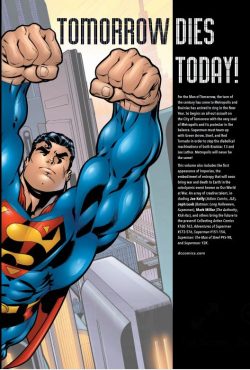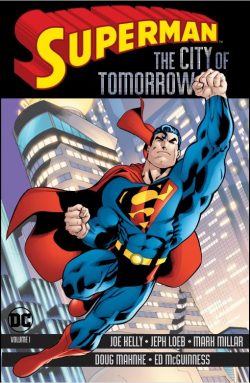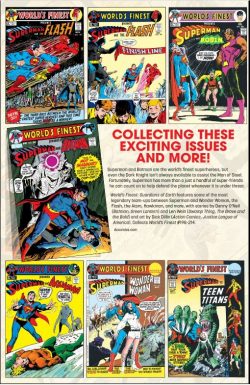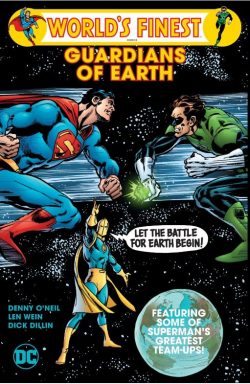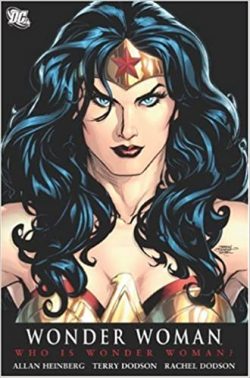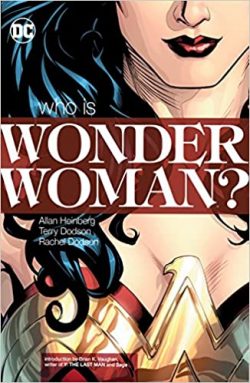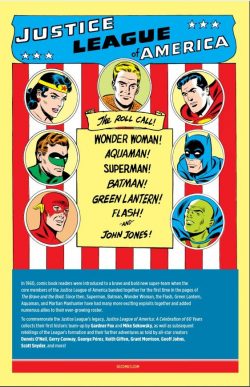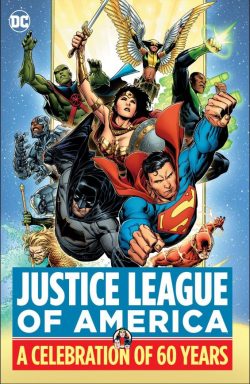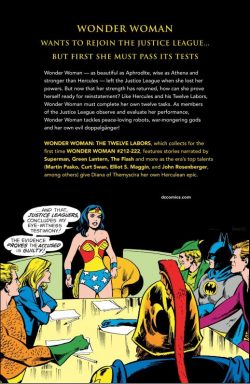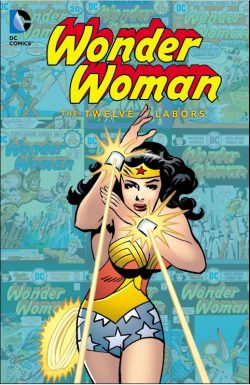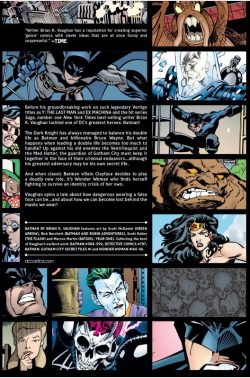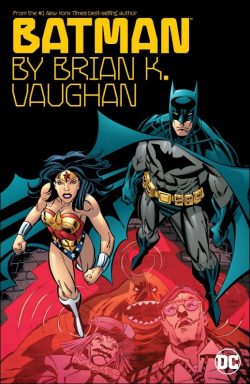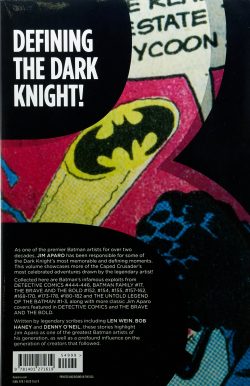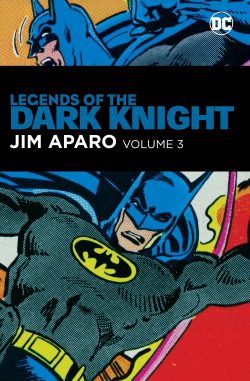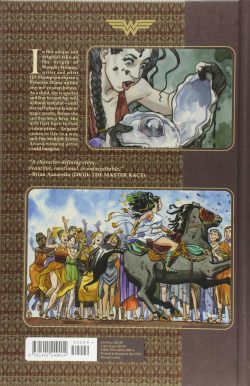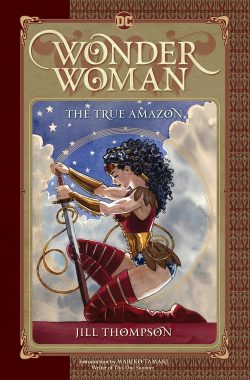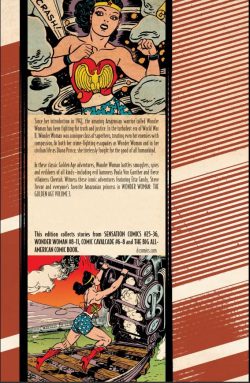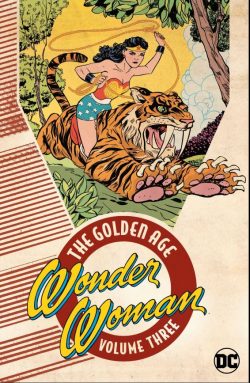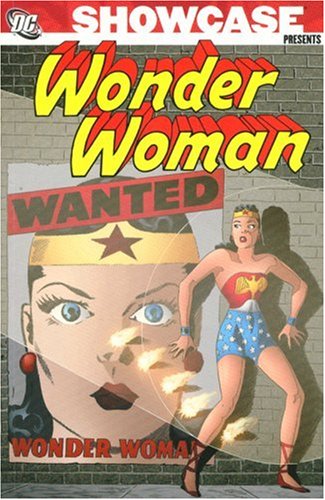
By Robert Kanigher, Ross Andru & Mike Esposito & various (DC Comics)
ISBN: 978-1-4012-1373-2 (TPB)
Until DC finally get around to republishing and digitally releasing their vast untapped comic treasures, I’m reduced to recommending some of their superb past printed glories whenever I feel like celebrating a key anniversary of the world’s preeminent female superhero who first caught the public’s attention in October 8 decades ago…
Wonder Woman was created by polygraph pioneer William Moulton Marston – apparently at the behest of his remarkable wife Elizabeth and their life partner Olive Byrne. The vast majority of the outlandish adventures were limned by classical illustrator by Harry G. Peter. She debuted in All Star Comics #8 (cover-dated December 1941) before gaining her own series and the cover-spot in new anthology title Sensation Comics a month later. She was an instant hit, and won her own eponymous title in late Spring of that year (Summer 1942).
Using the nom de plume Charles Moulton, Marston & Co scripted all the Amazing Amazon’s many and fabulous exploits until his death in 1947, whereupon Robert Kanigher took over the writer’s role. The venerable H.G. Peter continued until his own death in 1958. Wonder Woman #97 – in April of that year – was his last hurrah and the discrete end of an era.
This first cheap and cheerful monochrome Showcase collection covers what came next: specifically issues #98-117, spanning May 1958-October 1960.
With the notable exception of Superman, Batman, Wonder Woman and inoffensive back-up B-listers Aquaman and Green Arrow (plus – arguably – Johnny Quick, who held on until December 1954 and cowboy crimebuster Vigilante who finally bit the dust a month earlier), costumed heroes died out at the beginning of the 1950s, replaced by a plethora of merely mortal champions and a welter of anthologised genre titles.
When after almost no time at all, Showcase #4 rekindled the readership’s imagination and zest for masked mystery-men with a new iteration of The Flash in 1956, the fanciful floodgates opened wide once more. As well as re-imagining Golden Age stalwarts such as Green Lantern, The Atom and Hawkman, National/DC consequently updated all its hoary survivors such as the aforementioned Emerald Archer and Sea King. Also included in that revitalising agenda were the company’s High Trinity: Man of Steel, Caped Crusader and the ever-resilient Princess of Power…
Artists Ross Andru & Mike Esposito had debuted as cover artists 3 issues earlier, but with opening inclusion Wonder Woman #98 they took over the entire comic book as Robert Kanigher reinvented much of the old mythology and even tinkered with her origins in ‘The Million Dollar Penny!’ when goddess Athena visits an island of super-scientific immortal women, informing Queen Hippolyta that she must send an emissary and champion of justice to crime-ridden “Man’s World.â€
Declaring an open competition for the job, the queen isn’t surprised when her daughter Diana wins and is given the task of turning a penny into a million dollars in a day – all profits going to children’s charities, of course…
Just as the new Wonder Woman begins her coin chore, American airman Steve Trevor bails out of his malfunctioning jet high above the magically hidden isle, unaware that should any male set foot on Amazon soil the immortals would lose all their powers. Promptly thwarting impending disaster, Diana and Steve team up to accomplish her task, encountering along the way ‘The Undersea Menace’ before building ‘The Impossible Bridge!’
Issue #99 opened in similar bombastic fashion with ‘Stampede of the Comets!’ as Trevor is lost undertaking a pioneering space mission and Wonder Woman goes to his rescue thanks to incredible Amazon engineering ingenuity. After foiling an alien attack against Earth, the reunited lovers return in time for the introduction of the Hellenic Heroine’s new covert identity as Air Force Intelligence Lieutenant Diana Prince in ‘Top Secret!’ – beginning a decade of tales with Steve perpetually attempting to uncover her identity and make the most powerful woman on Earth his blushing bride, whilst his bespectacled, glorified secretary stands unnoticed, exasperated and ignored right beside – or slightly behind – him…
The 100th issue was a spectacular battle saga commencing with ‘The Challenge of Dimension X!’ and an alternate Earth Wonder Woman competing with the Amazing Amazon for sole rights to the title: all culminating with a deciding bout in ‘The Forest of Giants!’, whilst ‘Wonder Woman’s 100th Anniversary!’ deals with the impossibility of capturing the far-too-fast and furious Amazon’s exploits on film for Paradise Island’s archives…
‘The Undersea Trap!’ opened #101, with Steve tricking his “Angel†into agreeing to marry him if she has to rescue him three times in 24 hours (just chalk it up to simpler times, or you’ll pop a blood vessel, OK?) after which the odd couple are trapped by a temporal tyrant in ‘The Fun House of Time!’
Steve’s affection and wits are tested by an alien giant in ‘The Three Faces of Wonder Woman’ when he’s forced to pick out his true love from a trio of identical duplicates to save the world in #102, before ‘The Wonder Woman Album’ returns to the previously explored “impossible-to-photograph†theme in #103, but devotes most space to sinister thriller ‘The Box of Three Dooms!’ wherein the murderous Gadget Maker attempts to destroy the Amazon with a booby-trapped gift.
‘Trial By Fire’ pits Diana Prince against a host of deadly traps only Wonder Woman could survive after which ‘Key to Deception!’ closes #104 by reintroducing Golden Age villain the Duke of Deception as a militaristic Martian marauder in a gripping interplanetary caper.
Issue #105 debuted Wonder Girl in the ‘Secret Origin of Wonder Woman’, revealing how centuries ago the gods and goddesses of Olympus bestowed unique powers on the daughter of Queen Hippolyta and how – as a mere teenager – the indomitable Diana brought the Amazons to Paradise Island. Continuity – let alone consistency and rationality – were never as important to Kanigher as strong story or breathtaking visuals, and this eclectic odyssey is a great yarn that simply annoyed the heck out of a lot of fans… but not as much as the junior Amazon would in years to come…
Second feature ‘Eagle of Space’ is a more traditional tale of predatory space Pterodactyls and a dinosaur planet where Steve and Diana lend a civilising hand to the indigenous caveman population.
‘The Human Charm Bracelet!’ in #106 sees Wonder Woman battling an unbeatable extraterrestrial giant who wants Earth for his plaything, and her younger self encounters a chameleonic lass in ‘The Invisible Wonder Girl!’
The high fantasy adventures of the junior heroine clearly caught somebody’s fancy as they started coming thick and fast: ‘Wonder Woman – Amazon Teen-Ager!’ opened #107 as the youngster finds a romantic interest in merboy Ronno, undergoing a quest to win herself a superhero costume, whilst her adult self is relegated to a back-up battle against ‘Gunslingers of Space!’
‘Wanted… Wonder Woman!’ features Flying Saucer aliens framing our heroine for heinous crimes as a precursor to a planetary invasion and ‘The Stamps of Doom!’ offers a plot by another murderous inventor to kill the Princess in #108, before the next issue steps back in time to feature ‘Wonder Girl in Giant Land’ with the nubile neophyte easily overcoming ambush by colossal aliens. Her mature self is represented by ‘The Million Dollar Pigeon!’ wherein gangsters think they’ve found a foolproof method of removing the Amazing Amazon from their lives…
Wonder Woman #110 was a full-length saga with the indomitable warrior maid searching Earth for a missing alien princess in ‘The Bridge of Crocodiles!’ If the wanderer can’t be found, her concerned family intend laying waste the entire planet…
In #111, ‘The Robot Wonder Woman’ commissioned by gangsters provides no competition for the genuine article, whilst ‘Battle of the Mermen!’ sees Wonder Girl drawn into a sub-sea rumble between competing gangs of teenaged fish-boys…
The youthful incarnation led off the next issue. ‘Wonder Girl in the Chest of Monsters!’ takes the concept to unparalleled heights of absurdity as, in contemporary times, a heroic girl is rewarded with three Amazon wishes and travels back in time for an adventure with Wonder Woman’s younger self, whilst #113 return to relatively straight action with ‘The Invasion of the Sphinx Creatures!’ with the Adult Amazon battling the ancient weapons of a resurrected Pharoah-Queen, before ‘Wonder Girl’s Birthday Party!’ recounts how each anniversary event seems to coincide with geological disaster, mythological menace or uncanny event…
Aliens once more attack in #114’s ‘The Monster Express!’, turning parade balloons into ravening monsters until Diana and Steve intercede, after which ‘Wonder Girl’s Robot Playmate!’ demonstrate how hard it is growing up special…
Old enemy Angle Man returns revamped for the Silver Age in #115’s ‘Graveyard of Monster Ships!’ whilst ‘Mer-Boy’s Undersea Party!’ proves that above or below the waves Wonder Girls just don’t want to have fun, whilst in #116 both Ronno and Young Diana prove capable of serious heroism in ‘The Cave of Secret Creatures!’, before the Adult Amazon finally stops a millennial menace to mankind in ‘The Time -Traveller of Terror!’
This initial enchanting epistle concludes with Wonder Woman #117 wherein ‘The Fantastic Fishermen of the Forbidden Sea!’ revive Golden Age stars Etta Candy and the Holliday Girls – in modernised, marginally less offensive incarnations – for a fantastic tale of aquatic invaders before Amazon time-travel techniques allow the impossible to occur when ‘Wonder Girl Meets Wonder Woman!’… or do they?
By modern standards these exuberant, effulgent fantasies are all-out crazy, but as examples of the days when less attention was paid to continuity and concepts of shared universes and adventure in the moment were paramount, these outrageous romps simply sparkle with fun, thrills and sheer spectacle.
Wonder Woman is rightly revered as a focal point of female strength, independence and empowerment, but the welcoming nostalgia and easy familiarity of these costumed fairy tales remain a delight for all open-minded readers with the true value of these exploits being the incredible quality of entertainment they provide.
© 1958-1960, 2007 DC Comics, Inc. All Rights Reserved.

